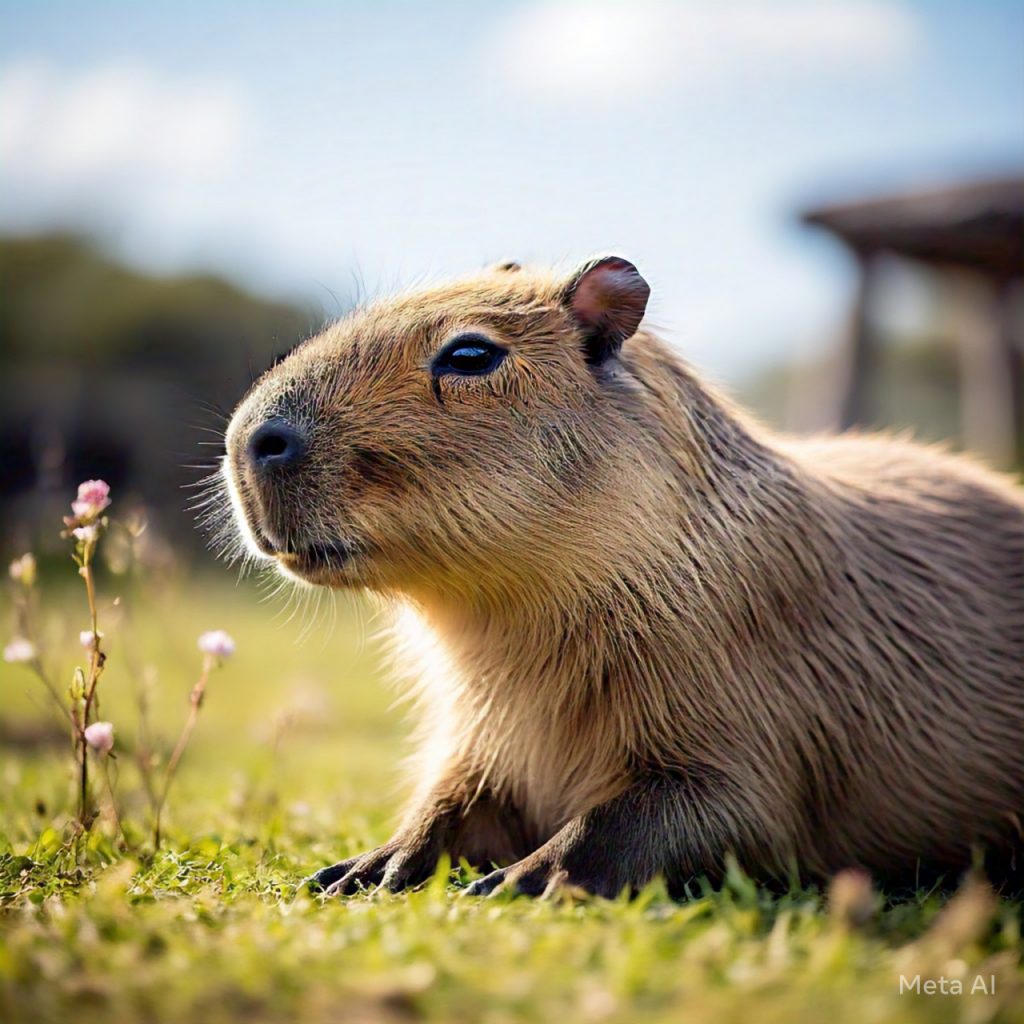What is a Capybara?
Capybaras belong to the rodent family and are closely related to guinea pigs and rock cavies. Their name comes from the Tupi language, meaning “grass eater,” reflecting their herbivorous diet.
Physical Characteristics
- Size: Adults are typically 39-51 inches long and 20-25 inches tall at the shoulder.
- Weight: 77-146 pounds, making them the largest rodents in the world.
- Lifespan: 8-12 years in captivity; 4-8 years in the wild.
- Distinctive Features:
- Webbed feet for swimming.
- Short, dense fur that repels water.
- Large, barrel-shaped bodies with blunt noses and small ears.
Natural Habitat and Distribution
Where Do Capybaras Live?
Capybaras are native to South America and thrive in tropical and temperate climates. They are commonly found in:
- Wetlands.
- Rivers, streams, and ponds.
- Marshes and flooded grasslands.
Countries of Origin
Brazil, Venezuela, Colombia, Argentina, and other parts of the continent, with large populations in the Amazon Basin.
Adaptations for Semi-Aquatic Life
- Webbed Feet: For efficient swimming.
- Nostrils and Eyes: Positioned high on their heads, allowing them to breathe and see while submerged.
- Social Behavior: Living in groups near water helps them evade predators.
Diet and Feeding Habits
Capybaras are strict herbivores, grazing on grasses, aquatic plants, and occasional fruits.
What Do Capybaras Eat?
- Grasses: Comprising 80% of their diet.
- Aquatic Vegetation: Especially in wetter regions.
- Fruits and Bark: As seasonal supplements.
- Coprophagy: Eating their own feces to reabsorb nutrients, particularly during the dry season.
Nutritional Adaptations
- Capybaras have specialized teeth that grow continuously, worn down by constant grazing.
- Their digestive systems are highly efficient, breaking down cellulose in fibrous plants.
Behavior and Social Structure
Are Capybaras Social Animals?
Yes, capybaras are highly social and live in groups of 10-20 individuals, though groups of up to 100 may form during the dry season.
Hierarchy and Communication
- Dominance: Led by an alpha male who oversees mating and group dynamics.
- Communication:
- Vocalizations like whistles, grunts, and barks signal danger, mating calls, or group cohesion.
- Scent marking by males with specialized glands.
Reproduction and Lifecycle
Breeding Habits
- Season: Rainy seasons are peak breeding times.
- Gestation Period: Around 150 days.
- Litter Size: Typically 4-6 pups.
Parental Care
- Pups are precocial, born with open eyes and the ability to graze within days.
- Mothers nurse all young in the group, fostering communal care.
Capybaras as Exotic Pets
Capybaras have become sought-after exotic pets due to their docile and affectionate nature. However, owning one requires significant dedication.
Legal Considerations
- Ownership laws vary by country and region. Some places require permits or ban capybaras outright.
- Check local wildlife regulations before considering ownership.
Housing Requirements
- Space: Large outdoor enclosures with plenty of room for grazing and swimming.
- Water: Access to a pond, pool, or similar body of water is essential.
- Shelter: Protection from extreme weather.
Diet in Captivity
- Fresh grass or hay.
- Vegetables like carrots, sweet potatoes, and leafy greens.
- Commercial guinea pig pellets as supplements.
Social Needs
Capybaras are not solitary animals and require companionship, ideally with other capybaras or similar animals like goats or rabbits.
Health and Wellness
Common Health Issues
- Dental Problems: Overgrown teeth if not properly worn down.
- Obesity: From overfeeding or insufficient exercise.
- Skin Infections: Particularly in damp environments.
Veterinary Care
Capybaras require exotic animal veterinarians familiar with their unique needs. Regular check-ups and preventative care are essential.
Ecological Importance
Capybaras play a vital role in their ecosystems:
- Grazing: Helps maintain wetland vegetation.
- Prey Species: Provide food for predators like jaguars, caimans, and anacondas.
- Seed Dispersal: Their diet aids in spreading plant seeds.
Cultural Significance
In South America
Capybaras are an integral part of local cultures, used as a food source in some regions and celebrated in folklore and traditions.
Global Popularity
Their laid-back demeanor and photogenic appearances have made them social media sensations, often depicted lounging with other animals in zoos or nature reserves.
Interesting Facts About Capybaras
- Natural Swimmers: Capybaras can stay underwater for up to 5 minutes to avoid predators.
- Unique Feet: Their webbed toes help them move efficiently on land and in water.
- Eco-Friendly Grazers: Their feeding habits help maintain biodiversity in wetlands.
- Social Bonds: They groom each other regularly to strengthen social ties.
Should You Get a Capybara?
Owning a capybara is not for everyone. Their social, dietary, and environmental needs require careful planning and significant resources. If you’re committed to meeting these requirements, a capybara can be a rewarding companion.
Final Thoughts
The capybara is a remarkable species, blending charm, intelligence, and ecological importance. Whether admired in the wild, as a pet, or through viral internet posts, these gentle giants continue to fascinate people worldwide.
If you’re interested in capybaras, start by researching their natural behaviors and requirements to ensure you can appreciate them responsibly, whether as a pet owner, conservationist, or wildlife enthusiast.

